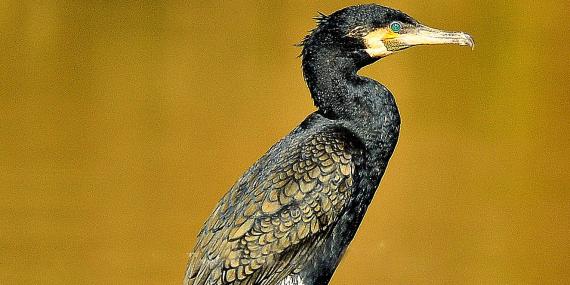White-fronted Goose
The White-fronted Goose is a common winter visitor, arriving from Greenland and Siberia at the end of October onwards and returning north again at the end of March. It eats roots, shoots, tubers and leaves, as well as grains and oats.
Britain is an important stopover for many wintering migrant species, so it is vital that we protect the places they rely on. But the survival of our waterbirds is threatened by the loss and degradation of many of our wetland habitats. The Wildlife Trusts manage many wetland nature reserves for the benefit of the wildlife they support. You can help by supporting your local Trust and becoming a member; you'll find out about exciting wildlife happenings, events on your doorstep and volunteering opportunities, and be helping local wildlife along the way.

Greylag Goose
Our commonest native goose, the Greylag Goose can be very territorial while nesting, chasing other geese and large birds away from its nesting site. Greylag Geese become sociable again once the chicks have hatched, with several families of goslings sometimes grouping together. Greylag Geese have short bills and prefer to graze pasture and meadows where cattle or sheep are grazing. They will also take grain, root crops and leafy vegetation.
The survival of our waterbirds is threatened by the loss and degradation of many of our wetland habitats. The Wildlife Trusts manage many wetland nature reserves for the benefit of the wildlife they support. You can help by supporting your local Trust and becoming a member; you'll find out about exciting wildlife happenings, events on your doorstep and volunteering opportunities, and be helping local wildlife along the way.
Whooper Swan
One of the two 'wild swans' that spend their winters in this country, Whooper Swans arrive from Iceland in late autumn returning north again in the spring. They will often feed on fields during the day, eating crops, before coming in to roost on open water.
The Whooper Swan is a rare breeding bird in Britain. The survival of our waterbirds is threatened by the loss and degradation of many of our wetland habitats. The Wildlife Trusts manage many wetland nature reserves for the benefit of the wildlife they support. You can help by supporting your local Trust and becoming a member; you'll find out about exciting wildlife happenings, events on your doorstep and volunteering opportunities, and be helping local wildlife along the way.

Bewick's Swan
One of the two 'wild swans' that spend their winters in this country, Bewick's Swans arrive from Siberia in late autumn returning north again in the spring. They will often feed on fields during the day, eating crops, before coming in to roost on open water.
The survival of our waterbirds is threatened by the loss and degradation of many of our wetland habitats. The Wildlife Trusts manage many wetland nature reserves for the benefit of the wildlife they support. You can help by supporting your local Trust and becoming a member; you'll find out about exciting wildlife happenings, events on your doorstep and volunteering opportunities, and be helping local wildlife along the way.
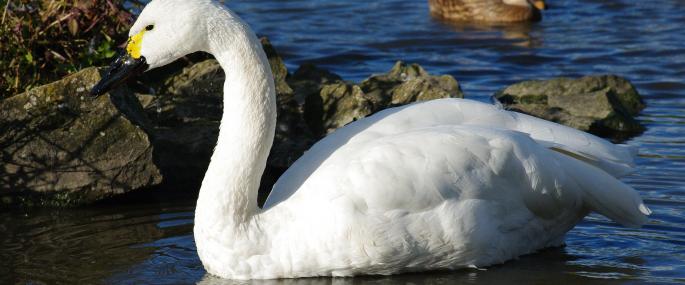
Mute Swan
The Mute Swan is one of the most familiar birds in Britain, its long, curved neck and graceful glide a regular sight on our waterways and waterbodies. Mute Swans feed on plants, particularly waterweed. They usually mate for life, but some will have numerous partners.
The survival of our waterbirds is threatened by the loss and degradation of many of our wetland habitats. The Wildlife Trusts manage many wetland nature reserves for the benefit of the wildlife they support. You can help by supporting your local Trust and becoming a member; you'll find out about exciting wildlife happenings, events on your doorstep and volunteering opportunities, and be helping local wildlife along the way.
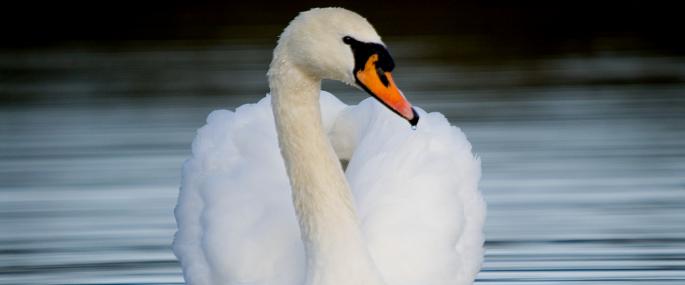
Little Egret
The Little Egret is a small, white heron which feeds on small fish and crustaceans. Once a very rare visitor from the Mediterranean, Little Egrets are now a common sight around the coasts of southern England and Wales as they expand their range, possibly due to climate change. It first bred in the UK on Brownsea Island, Dorset, in 1996, and has been moving northwards ever since; it was recorded as breeding in Berkshire for the first time in 2007.
With the effects of climate change becoming more apparent - from unseasonal flooding to warmer winters - it is quite likely that more wildlife will be able to expand its range. This might be good for those species that are threatened, but it may cause competition between species and unbalance natural habitats. The Wildlife Trusts are working with other organisations and individuals to create a 'Living Landscape': a network of habitats stretching across town and country, allowing wildlife to adapt to climate change and move about freely, and people to enjoy the benefits of nature. Support this greener vision for the future by joining your local Wildlife Trust.
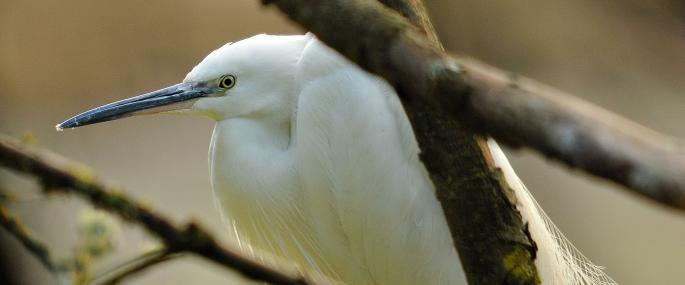
Grey Heron
A tall, often solitary bird, the Grey Heron is one of Britain's most familiar birds. It feeds mainly on fish, but also eats small mammals (even Moles!), waterbirds (sometimes up to the size of a Coot) and Crayfish. It is often seen standing stock-still in the shallow waters of lakes, rivers and ponds, patiently hunting fish flitting about below the surface. It will visit gardens with ornamental ponds, looking for an easy meal.
The survival of our waterbirds is threatened by the loss and degradation of many of our wetland habitats. The Wildlife Trusts manage many wetland nature reserves for the benefit of the wildlife they support. You can help by supporting your local Trust and becoming a member; you'll find out about exciting wildlife happenings, events on your doorstep and volunteering opportunities, and be helping local wildlife along the way.
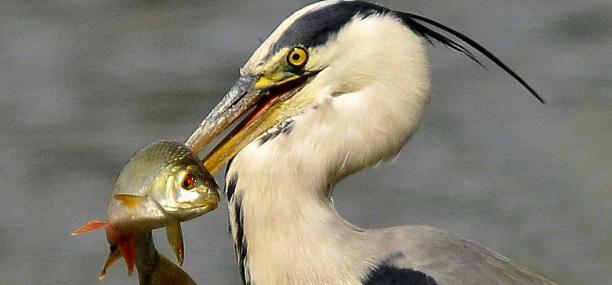
Bittern
A rare, shy heron, Bitterns spend almost all their time hidden away in large reedbeds, where they feed on eels and other fish. Bitterns have wonderfully camouflaged plumage, helping them to blend into the reeds. They can also stand motionless for long periods to avoid detection.
Bitterns are one of the UK's most rare and threatened birds - the reedbeds they depend on are disappearing through pollution, agriculture and the inundation of coastal sites as sea levels rise. The Wildlife Trusts are working closely with planners, developers and farmers to ensure our reedbeds are protected. And careful habitat management carried out by The Wildlife Trusts on local nature reserves where Bitterns live help them to survive. By volunteering for your local Trust you can help too, and you'll make new friends and learn new skills along the way.
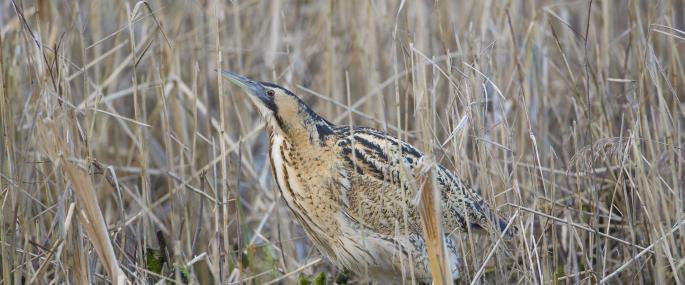
Shag
Shags are large, dark waterbirds, a little bit smaller than Cormorants. They feed on fish, which they catch with their long, hook-tipped bills while swimming underwater. Shags nest on cliffs around our coasts but are very rarely seen inland. They can often be spotted perched with their wings held stretched out to dry their feathers off which are not waterproof.
The survival of our seabirds is threatened by the pollution and degradation of our marine and coastal habitats. The Wildlife Trusts are working with fishermen, researchers, politicians and local people towards a vision of 'Living Seas', where marine wildlife thrives. This work has recently had a massive boost with the passing of the Marine Bill, promising sustainable development of the UK's marine environment. Do your bit for our Living Seas by supporting your local Wildlife Trust.
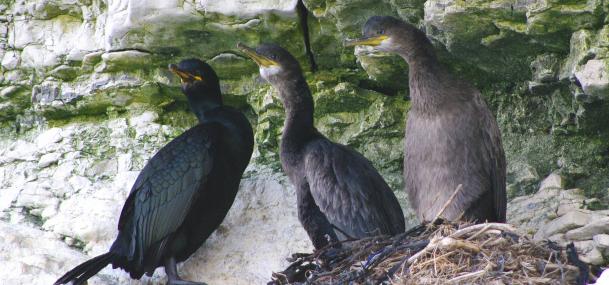
Cormorant
Cormorants are large, dark waterbirds. They feed on fish, which they catch with their long, hook-tipped bills while swimming underwater. Cormorants nest on low cliffs around the coasts, or in colonies in trees on lakes and flooded gravel pits inland. Cormorants can often be spotted perched on a rock or bank with their wings held stretched out. In this stance, they are able to dry their feathers off which are not waterproof.
Historically, the Cormorant was heavily persecuted because it was seen as a greedy and sinister bird; as good fishers, they came into conflict with anglers. But they survived here and are now regularly seen both on our coasts and inland, including on man-made lakes, flooded gravel pits and reservoirs. The Wildlife Trusts work with planners, water companies and landowners to help make our man-made waterways and waterbodies as good for wildlife as they are for people. By working together, we can create a 'Living Landscape': a network of habitats stretching across town and country, allowing wildlife to move about freely and people to enjoy the benefits of nature. Support this greener vision for the future by joining your local Wildlife Trust.
